The Battery of Southeast Asia
Air Date: Week of October 23, 2009
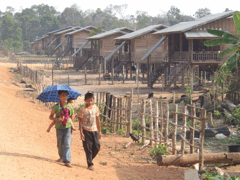
The Nam Theun 2 Power Company built 17 new villages for people whose homes and fields were flooded. (Mary Stucky)
Across Southeast Asia, hydroelectric dams are being planned and built along the biologically diverse Mekong River and its tributaries. In Laos, seven large dams are currently under construction, tapping much of the electricity for export to bring in needed revenue and development for the struggling nation. But environmental groups in the region oppose these big dams, calling them threats to Laos' amazing biodiversity. Mary Stucky traveled to Laos and has our report.
Transcript
YOUNG: It's Living on Earth – I’m Jeff Young.
CURWOOD: And I’m Steve Curwood. In the United States, Canada and Europe, some old hydroelectric dams are being torn down, rejected as environmentally destructive or too expensive to repair or replace. But that’s not the case in parts of the developing world, including Southeast Asia. There dams are being built along the biologically rich Mekong River and its tributaries. In just one small country, Laos, seven large dams are currently under construction, and over 50 more are on the drawing board. As Mary Stucky reports, some see this as a major threat to biodiversity.
[SOUNDS OF MARKET; VOICES; RUSTLING SOUNDS]
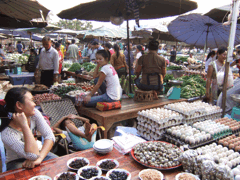
Market on the outskirts of Vientiane, Laos. Scientists have made new species discoveries in markets such as this.
Photo: Mary Stucky
STUCKY: At a bustling food market on the outskirts of Vientiane, the capital of Laos, vendors -- many of them women and children sit behind tables topped with umbrellas. There are piles of cabbage, bright red chilies in plastic bowls, and tiny speckled eggs stacked in cardboard cartons. Then there are the real delicacies -- from furry rodents to deep-fried insects.
CHAPMAN: This is fine local Lao fare. It tastes good too actually. I do recommend the crickets.
STUCKY: That’s Stuart Chapman of the World Wildlife Fund. He says markets like this one offer a tremendous variety of food and some amazing scientific discoveries.
CHAPMAN: Of course when you have people living in close proximity to the forest, these people come across the rare, the endangered and the unusual and in very many cases they are considered to be food and end up in markets such as this.
STUCKY: Chapman says scientists have been discovering an average of two new species every week for the last ten years in and along Southeast Asia’s Mekong River. Among them – a bright pink millipede that produces cyanide in defense; a rat thought to be extinct for 11 million years; and a spider the size of a dinner plate.
CHAPMAN: The Mekong should now be synonymous with Amazon, with Borneo, with Congo. It conjures up images of wild places and I tell you it doesn’t get much wilder than this.
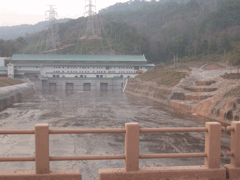
The Nam Theun 2 dam project is expected to bring two billion dollars into Laos. Mary Stucky
STUCKY: Chapman says that wildness and the Mekong’s unique biodiversity are at risk – victims of hunting, deforestation and development – specifically hydroelectric dams. The Laos Mekong is well suited for hydropower and officials here want Laos to become what they call “the battery of Southeast Asia.” Earning billions by building dams and selling the electricity they produce to neighboring countries.
[WHIRRING ENGINE SOUND]
STUCKY: In Central Laos, a road grader levels a two-lane highway near a major tributary of the Mekong River. It’s part of the massive one and a quarter billion dollar Nam Theun two dam project that’s expected to generate 1,070 megawatts by the end of the year. Aiden Glendinning represents the private company building the dam with funding from international shareholders and loans from the Asian Development Bank and the World Bank. Glendinning says revenue from the project will be used by the government to develop the country and reduce poverty.
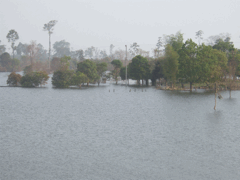
Areas flooded by the Nam Theun 2 dam project.
(Photo: Mary Stucky)
GLENDINNING: 95 percent of the electricity will be sold to Thailand at a pre-arranged rate as a guaranteed customer. So it provides financial security for the government. They’re going to get two billion dollars in royalties from the dam over the next 25 years and after that then they own the whole lot.
STUCKY: 19 villages have been flooded to create a 174 square mile reservoir for the dam. More than 6,000 people had to move, their rice fields and riverbank gardens flooded, their fisheries lost. Still, Nam Theun Two is meant to be a model for how to minimize environmental damage and lift the country out of poverty.
GLENDINNING: The Minister of Foreign Affairs here several years ago told diplomats and aid workers that the Lao people didn’t want to live in a museum that other people can come to visit and enjoy. They wanted to have better lives. They wanted refrigerators and cars and education for their children. And you can’t begrudge them that.
[CHILDREN VOICES]
STUCKY: The power company built 17 new villages for people whose homes and fields were flooded. These villages have new schools, roads medical clinics, and improved water supplies. Each family was given a new house complete with a latrine and electricity. Few residents would talk on tape but many say they’re happy with the houses and roads. But these improved living conditions haven’t reduced their worries about how to make living.
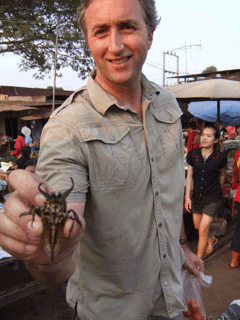
The World Wildlife Fund’s Stuart Chapman with a Lao delicacy. (Mary Stucky)
[MAN SPEAKING LAO]
STUCKY: The fishing is okay, says this fisherman, but there aren’t enough buyers for his fish. Most Laotians are poor, desperate for jobs and a better economy, says Stephen Lintner, a technical advisor for the World Bank. He says this dam will help.
LINTNER: Nam Theun two is premised on the principle that it is a way for the government to generate revenues that can be applied to poverty reduction and better environmental management. If used properly that revenue can make a major contribution to the development futures of the country.
STUCKY: Lintner says dams help in another way – they can be used to fight the ravages of climate change.
LINTNER: What’s happening is with climate change you’re having less predictability of the amount of rainfall you’ll have, so that dams are being increasingly used to store water to allow for better regulation.
MIDDLETON: The Mekong region has an opportunity to leapfrog the destructive dam development we’ve seen in other regions of the world and instead jump into a renewable energy future, into a sustainable energy future. There are far better technologies now for generating electricity, which makes dams last century’s technology.
STUCKY: That’s Carl Middleton of International Rivers, an advocacy organization opposed to hydroelectric dams. Instead of building dams, Middleton wants western governments to assist Laos in developing energy alternatives such as solar and wind. In Laos, the Mekong River supports a fishery that’s estimated at $50 million a year. Middleton says dams will permanently damage the river threatening Laotians’ food security and livelihoods, water to irrigate their crops, and even transportation. Middleton says fishermen are often the first to feel the negative effects of dams, which can block migrations of many fish species and change the natural ebb and flow of the Mekong River.
[SOUND OF BOATS ON RIVER]
MIDDLETON: The biodiversity has adapted to the shape of the Mekong River’s flood pulse. Between an extreme high during the rainy season, and a relative low during the dry season, and it’s this shape, this characteristic that makes the ecosystem itself so productive. By building dams you’re changing the shape of this hydrograph. It will change the biodiversity of the region.
[BOAT MOTOR]

The Nam Theun 2 Power Company built 17 new villages for people whose homes and fields were flooded. (Mary Stucky)
STUCKY: A long tail boat heads to what’s called the Siphandone or “four thousand islands” in Southern Laos near the Cambodian border. These waters are home to one of the most magical species on earth – the Irrawaddy dolphins.
[BOATMAN SPEAKS LAO; MOTOR CUTS OUT; WATER LAPPING]
STUCKY: We stop within sight of the dolphin feeding grounds. Suddenly, a grey fin slices the water. In a flash, there’s another.
LAO MAN: The fish.
STUCKY: Dolphins, yeah! Oh, they’re beautiful. There are fewer than 80 Irrawaddy dolphins left in the Mekong, and their numbers are dwindling rapidly. A recent World Wildlife Fund report points to DDT, PCBs and mercury pollution. The government of Laos has accepted a proposal from a Malaysian company to build an enormous hydropower dam in the area where the dolphins come to feed. Opponents say the dam at Siphandone would devastate the remaining dolphins and affect fish catches dramatically. The World Wildlife Fund’s Chapman says areas like Siphandone should be avoided but he supports allowing some dams in less sensitive places and wants to be sure people are provided with a way to make a living.
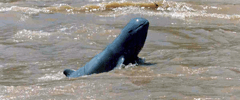
There are fewer than 80 Irrawaddy dolphins left in the Mekong and their numbers are dwindling rapidly.
Photo: Courtesy of the World Wildlife Fund
CHAPMAN: Yes, development is important to the welfare of our people, environment is also important to the welfare of our people. I don’t think there’s anywhere in on earth where you have the mixture of high biodiversity, yet high threat.
STUCKY: And, says Chapman that threat is not just in Laos. The Mekong River is more than 3,000 miles long and runs through six countries. Environmental groups have called for a multi-country agreement to preserve the river and its ecosystem. But so far countries on the Mekong are still proposing and building new dams as a way to meet the regions’ need for financial capital and for energy. For Living on Earth, I’m Mary Stucky, in Siphandone, Laos.
CURWOOD: For photographs – go to our website, LOE dot ORG
Links
Species discoveries of the last decade in the Greater Mekong
Living on Earth wants to hear from you!
Living on Earth
62 Calef Highway, Suite 212
Lee, NH 03861
Telephone: 617-287-4121
E-mail: comments@loe.org
Newsletter [Click here]
Donate to Living on Earth!
Living on Earth is an independent media program and relies entirely on contributions from listeners and institutions supporting public service. Please donate now to preserve an independent environmental voice.
NewsletterLiving on Earth offers a weekly delivery of the show's rundown to your mailbox. Sign up for our newsletter today!
 Sailors For The Sea: Be the change you want to sea.
Sailors For The Sea: Be the change you want to sea.
 The Grantham Foundation for the Protection of the Environment: Committed to protecting and improving the health of the global environment.
The Grantham Foundation for the Protection of the Environment: Committed to protecting and improving the health of the global environment.
 Contribute to Living on Earth and receive, as our gift to you, an archival print of one of Mark Seth Lender's extraordinary wildlife photographs. Follow the link to see Mark's current collection of photographs.
Contribute to Living on Earth and receive, as our gift to you, an archival print of one of Mark Seth Lender's extraordinary wildlife photographs. Follow the link to see Mark's current collection of photographs.
 Buy a signed copy of Mark Seth Lender's book Smeagull the Seagull & support Living on Earth
Buy a signed copy of Mark Seth Lender's book Smeagull the Seagull & support Living on Earth

